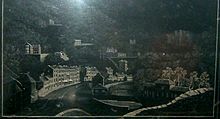Ashford Black Marble


Ashford Black Marble is the name given to a dark limestone, quarried from mines near Ashford-in-the-Water, in Derbyshire, England. Once cut, turned and polished, its shiny black surface is highly decorative. Ashford Black Marble is a very fine-grained sedimentary rock, and is not a true marble in the geological sense. It can be cut and inlaid with other decorative stones and minerals, using a technique known as pietra dura.
History
The mineral has been used decoratively since prehistoric times; the first recorded customer was Bess of Hardwick in 1580.[1]
Henry Watson, the uncle of Derbyshire geologist

There was a thriving trade in the manufacture of urns, obelisks and other decorative items from Ashford Black Marble during the late 18th and early 19th century.
Geology
Although referred to as marble, the rock is of purely
Manufacturing techniques

The limestone can be turned on a lathe to create urns, candlesticks and other similar objects, or sawn to produce smooth, flat items such as obelisks and paperweights.
In the late 1780s Derbyshire geologist White Watson began to create explanatory geological tablets using Ashford Black Marble into which other local rocks were inlaid so as to represent the strata of the rocks in different parts of the county.[7] Derby Museum has a diagram of Ecton Hill (see picture) made from Ashford Black Marble and other minerals.[8]
William Martin, who at one time worked with Watson, wrote the first scientific study of fossils. His Petrifacta Derbiensia recounts that White Watson's uncle and workers at the Black Marble quarry called some of the fossils "crocodile tails" as they thought they were the remains of crocodiles.[5]
The craft of inlaying black marble was resumed in the 1990s by Don Edwards, who ran a rock and mineral dealership in the Derbyshire village of Tideswell. In 2006 it was announced that Buxton Museum had purchased the Black Marble collection that had been left by John Michael Tomlinson. He had spent over 50 years putting together the collection after finding that his ancestors had been involved in Ashford Black Marble manufacturing.[9] Derby Museum has a diagram of Ecton Hill made from Ashford Black Marble and other minerals.[8]
See also
References
- ^ a b c d "Bygone Industries of the Peak:Ashford Black Marble". Archived from the original on 9 August 2010. Retrieved 24 February 2011.
- ^ Cooper, Michael P. (30 April 2005). "The Devonshire Mineral Collection of Chatsworth House". Mineralogical Record. Archived from the original on 8 July 2011.
- ^ "Tomlinson Collection". Derbyshire County Council. Archived from the original on 25 May 2011. Retrieved 22 May 2011.
- ^ "Black marble to go under auction hammer". This Is Derbyshire. 6 June 2009. Archived from the original on 25 September 2012. Retrieved 22 May 2011.
- ^ a b Martin, William (1809). Petrificata Derbiensia p33-34. Retrieved 24 February 2011.
p39 Fig 4....A fossil shell. The original a nautilus ....The crocodile said to be found in the limestone of Ashford, appears to be just a large specimen of this or some other Orthoceratite
- ^ Bates, Tom (7 June 2007). "Ashford Black Marble". Archived from the original on 27 July 2011. Retrieved 22 May 2011.
- ^ Exhibition in the geology section of Derby Museum and Art Gallery, exhibited February 2011
- ^ a b "Newsletter of the Geological Curators Club Vol 1, No. 8, 1976" (PDF). Geological Curators Club. 1976. Archived from the original (PDF) on 16 July 2011. Retrieved 22 May 2011.
- ^ "Rare Ashford Black Marble Returns To Buxton Museum". Culture24. 31 January 2006. Retrieved 22 May 2011.
Sources
- Derbyshire Black Marble, John Michael Tomlinson, 1996, ISBN 0-904334-04-X
- The Gem of the Peak, William Adam, 1843
External links
- "Ashford Black Marble". TIDESWELL DALE ROCK SHOP. Retrieved 22 May 2011.
